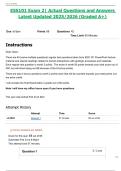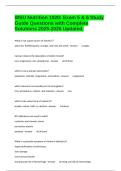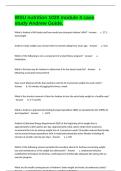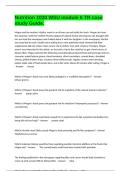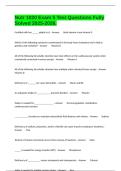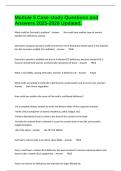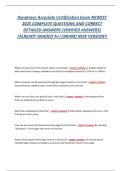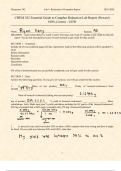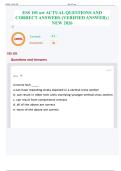University of Washington
Latest uploads at University of Washington. Looking for notes at University of Washington? We have lots of notes, study guides and study notes available for your school.
-
338
-
2
-
27
All courses for University of Washington
- ADULT HEALTH 2 EXAM- COMPREHENSIVE GUIDE 1
- Advanced Pathology - Midterm 2021-2022 1
- AP 100 1
- ATI Mental health A 1
- ATI Mental Health Review 1
- ATI Pharmacology Proctored Exam {UPDATED 2020} 1
- ATI Practice Assessment-Maternal Newborn Online Practice 2019 A & B 1
- ATI RN PROCTORED MIDTERM EXAM RETAKE 2021-2022.pdf 1
- CHEM 162 2
- Chem 162 Experiment #2: Electrochemistry 1
- Chem 162 Experiment #3: Intermolecular Forces 1
- CHEM 162 Experiment #5: Spectrochemical Serie 1
- CHEM 162 Experiment 1 Solubility 1
- CHEM 162 EXPERIMENT 4: I. Fractional Crystallization of KNO3 with 2Fe2.6H2O Impurity II. The Solubility Curve of KNO3 1
- CHEM 162 LAB #6: SYNTHESIS OF ASPIRIN 1
- CHEM CHEM 142 1
Latest content University of Washington
ESS101 Exam 2| Actual Questions and Answers Latest Updated 2025/2026 (Graded A+)
BIOC 405 Winter Quarter 2025 - Exam - Questions and Verified Answers (2026 / 2027 Update) Version B Content 1. The test consists of 27 questions. 2. Each question has ONE correct answer in bold 3. Each question is worth the same number of points. 1. Which ONE of the following statements is INCORRECT about the hemoglobin binding curves shown below? a. Transition from curve (a) to (c) can be achieved by raising the concentration of protons (as a result of metabolic activity)....
What is not a good source of vitamin E? plant oils, fortified grains, oranges, and nuts and seeds - Answer oranges Calcium reduces the absorption of which mineral? iron, magnesium, zinc, phosphorus - Answer all of them which is not a primary electrolyte? potassium, chloride, magnesium, and sodium - Answer magnesium which mineral is an essential part of hemoglobin? iron, phosphorus, calcium, and selenium - Answer iron which is the active form of vitamin D? ...
What is Andrew's BMI today and how would you interpret Andrew's BMI? - Answer c. 27.3, Overweight Andrew's body weight was normal when he started college four years ago. - Answer a. True Which of the following is not a component of a total fitness program? - Answer a. Meditation What is the best way for Andrew to determine if he has excess body fat? - Answer b. Obtaining a bod pod measurement How much physical activity does Andrew need to do to promot...
Megan and her mother, Martha, went to an all-you-can-eat buffet for lunch. Megan ate from the salad bar, while her mother Martha sipped all-natural herbal slimming tea she brought with her and read the newspaper and chatted about it with her daughter. In the newspaper, Martha was surprised to read a health story stating that a new published study showed that fiber supplements did not reduce colon cancer risk in elderly men with a history of polyps. Megan wasn't very interested in the article,...
Fortified milk has _____ added to it. - Answer Both vitamin A and vitamin D Which of the following nutrients is synthesized in the body from cholesterol and is tied to genetics and evolution? - Answer Vitamin D All of the following fat-soluble vitamins have toxic effects on the cardiovascular system when consistently consumed in excess except: - Answer Vitamin A All of the following fat-soluble vitamins have multiple active chemical forms except: - Answer Vitamin...
What could be Gertrude's problem? - Answer She could have another type of anemia besides iron deficiency anemia. Gertrude's European ancestry could increase her risk of having low folate status if she exposed her skin to excess sunlight (UV radiation). - Answer TRUE Gertrude's anemia is probably not due to a vitamin B12 deficiency, because vitamin B12 is found in animal food sources and Gertrude eats plenty of these. - Answer TRUE What is most likely causing G...
Prepare for the Dynatrace Associate Certification Exam 2025 with comprehensive study materials, verified practice questions, and detailed answers. Ideal for IT professionals and students aiming to validate their Dynatrace monitoring and application performance skills.
CHEM 242 Essential Guide to Camphor Reduction Lab Report (Newest) 100% Correct - UOW Name____________________________________________ GRADING – each section below is worth 1 point. You must earn 4 out of 5 points to get credit for this lab report. You do not need perfect scores on each section to get credit for that section. SECTION 1 – Notebook Include all of your notebook pages for this experiment. Each of the following sections will be graded 0/1: Goal Safety informa...
ESS 101 uw ACTUAL QUESTIONS AND CORRECT ANSWERS (VERIFIED ANSWER) | NEW 2026

